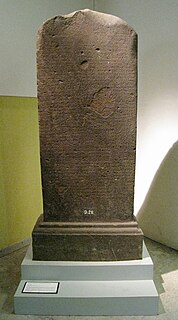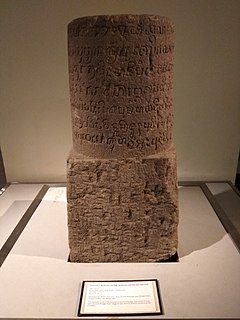Related Research Articles

Java is an island of Indonesia, bordered by the Indian Ocean on the south and the Java Sea on the north. With a population of over 141 million or 145 million, Java constitutes 56.7 percent of the Indonesian population and is the world's most-populous island. The Indonesian capital city, Jakarta, is on its northwestern coast. Much of the well-known part of Indonesian history took place on Java. It was the centre of powerful Hindu-Buddhist empires, the Islamic sultanates, and the core of the colonial Dutch East Indies. Java was also the center of the Indonesian struggle for independence during the 1930s and 1940s. Java dominates Indonesia politically, economically and culturally. Four of Indonesia's eight UNESCO world heritage sites are located in Java: Ujung Kulon National Park, Borobudur Temple, Prambanan Temple, and Sangiran Early Man Site.

Srivijaya was a Buddhist thalassocratic empire based on the island of Sumatra, Indonesia, which influenced much of Southeast Asia. Srivijaya was an important centre for the expansion of Buddhism from the 8th to the 12th century AD. Srivijaya was the first unified kingdom to dominate much of the Malay Archipelago. The rise of the Srivijayan Empire was parallel to the end of the Malay sea-faring period. Due to its location, this once-powerful state developed complex technology utilizing maritime resources. In addition, its economy became progressively reliant on the booming trade in the region, thus transforming it into a prestige goods-based economy.

The Laguna Copperplate Inscription, a legal document inscribed on a copper plate in 900 CE, is the earliest known calendar-dated document found in the Philippines. The date of the inscription would make it contemporary to the Balitung kingdom of Central Java, although it did not necessarily originate from that area.

The Shailendra dynasty was the name of a notable Indianised dynasty that emerged in 8th-century Java, whose reign signified a cultural renaissance in the region. The Shailendras were active promoters of Mahayana Buddhism with the glimpses of Hinduism, and covered the Kedu Plain of Central Java with Buddhist monuments, one of which is the colossal stupa of Borobudur, now a UNESCO World Heritage Site.

The Medang Kingdom or Mataram Kingdom was a Javanese Hindu–Buddhist kingdom that flourished between the 8th and 11th centuries. It was based in Central Java, and later in East Java. Established by King Sanjaya, the kingdom was ruled by the Sailendra dynasty.

Sanjaya dynasty was an ancient Javanese dynasty that ruled the Mataram kingdom in Java during first millennium CE. The dynasty was an active promoter of Hinduism in ancient Java.

King Sanjaya of Mataram or in complete stylized name known as Rakai Mataram Sang Ratu Sanjaya was the founder of Mataram Kingdom during the eighth century. His name was revealed in the AD 732 Sanskrit Canggal inscription carved in a stone found at Gunung Wukir temple that stood on Wukir or Ukir hill on the southern Kedu Plain in Central Java.
Panangkaran or formal regnal name Mahārāja dyāḥ Pañcapaṇa kariyāna Paṇaṃkaraṇa was the king of Shailendra dynasty and also the ruler of Mataram Kingdom between AD 760—775, the kingdom of which its power centralized on Java island of Indonesia. Crowned as Rakai Panangkaran, he was the immediate successor of Sri Sanjaya, the founder of Sanjaya Dynasty as mentioned in the Kalasan inscription. The name of Panangkaran is mentioned in the Balitung charter as the line of kings who were named as the 'builders of kraton'.
Sri Maharaja Rakai Watukura Dyah Balitung Sri Dharmodaya Mahasambu was the king of the Kingdom of Mataram. He reigned circa 899–911. His territories included Central Java, East Java, and Bali. In 907 he created the Mantyasih inscription, containing the list of Medang kings. He also mentioned in Kaladi inscription.
Pramodhawardhani was the queen consort of king Rakai Pikatan of Medang Kingdom in 9th century Central Java. She was the daughter of Sailendran king Samaratungga. Her royal marriage to Pikatan, the prince of Sanjaya dynasty, was believed as the political reconciliation between Buddhist Sailendra with Hindu Sanjaya dynasties.
The Mantyasih inscription is an important inscription found in the village of Mateseh, North Magelang, Central Java, Indonesia. It is dated to 907 and was created by King Balitung from Sanjaya dynasty, of the Ancient Medang Kingdom. This inscription contains a genealogy of the kings of Medang before King Balitung.

Kalingga was a 6th-century Indianized kingdom on the north coast of Central Java, Indonesia. It was the earliest Hindu-Buddhist kingdom in Central Java, and together with Kutai and Tarumanagara are the oldest kingdoms in Indonesian history.

The Minto Stone or Sanggurah Inscription, known in Indonesia as Prasasti Sanggurah, is a 3 long tons (3.0 t), 2 metres (6.6 ft) tall epigraphy found in Malang, East Java province. In 1812, Sir Thomas Stamford Raffles, then Lieutenant-Governor of the island of Java, removed it along with the so-called "Calcutta Stone" as a token of appreciation to his superior, then British Governor-General of India, Lord Minto. It consequently became part of the Minto family estate near Hawick, Roxburghshire, Scotland.
Karangtengah inscription is the inscriptions written on five pieces of stones dated 746 Saka or 824 CE, discovered in Karangtengah hamlet, Temanggung Regency, Central Java, Indonesia. The inscription was written in ancient Javanese script in two languages; Old Javanese and Sanskrit. The lines 1-24 was written in Sanskrit, the rest of the lines was written in old Javanese. The inscription is linked with the temple Borobudur and Mendut

The Shivagrha inscription is an inscription from the Medang Kingdom of Central Java, dated in chandrasengkala (chronogram) ”Wwalung Gunung sang wiku”, that is, the year 856 CE. The inscription was inscribed by order of Dyah Lokapala right after the end of Rakai Pikatan's reign, and gave a detailed description of a grand temple compound dedicated to Shiva called Shivagrha, corresponding to the Prambanan temple compound.
Medang Kamulan was a semi-mythological kingdom that believed to be once established somewhere in Central Java according to Javanese mythology. It is either perceived as the predecessor or the actual historical kingdom of Medang Kingdom. "Kamulan" derived from the word "mula" in Javanese means "origin", so "Medang Kamulan" can be interpreted as "pre-Medang" or "Medang the origin".

The Kingdom of Bali was a series of Hindu-Buddhist kingdoms that once ruled some parts of the volcanic island of Bali, in Lesser Sunda Islands, Indonesia. With a history of native Balinese kingship spanning from the early 10th to early 20th centuries, Balinese kingdoms demonstrated sophisticated Balinese court culture where native elements of spirit and ancestral reverence combined with Hindu influences – adopted from India through ancient Java intermediary – flourished, enriched and shaped the Balinese culture.

Anjuk Ladang inscription is a stone stele inscription dated to the year 859 Saka or 857 Saka issued by King Sri Isyana of Kingdom of Medang after moving his capital to the eastern part of Java. The inscription mentioned and honored the commendable deed of the people of Anjuk Ladang village on assisting Pu Sindok on repelling the invading Malay king in the year 937 CE. Thus King Pu Sindok has erected a monument of victory (jayastambha) to commemorate this heroic event.

Gunung Wukir temple, or Canggal temple, or also known as Shivalinga is a Shivaite Hindu temple dated from early 8th century, located in Canggal hamlet, Kadiluwih village, Salam subdistrict, Magelang Regency, Central Java, Indonesia. The temple dates to the year 732, making it the first structure attributed to the ancient Mataram kingdom, which ruled Central Java from 732 to around the middle of the tenth century.

Munggu Antan inscription is an inscription in the form of a stone stele found in the village of Bulus, Purworejo Regency, which was once included in the Kedu Residency. This inscription contains the designation of the village Munggu Antan as a sima dedicated to a temple in Gusali, and it is written in Sanskrit. This inscription was issued by Sang Pamegat Munggu and his younger sister Sang Hadyan Palutungan, who was also the wife of Sang Dewata at Pastika, at the behest of Sri Maharaja Rake Gurunwangi, dated 808 Saka or 887 CE.
References
- 1 2 3 "Prasasti Kaladi". Kekunaan (in Indonesian).
- ↑ Anjali Nayenggita. "Prasasti Kaladi 831 Saka". Perpustakaan Universitas Indonesia (Library of University of Indonesia).
- ↑ Hall, Kenneth R. (2010). A History of Early Southeast Asia: Maritime Trade and Societal Development, 100–1500 G - Reference, Information and Interdisciplinary Subjects Series. Rowman & Littlefield Publishers. p. 28. ISBN 9780742567627.
- ↑ "Prasasti yang membahas Multikulturalisme". Ministry of Education and Culture of the Republic of Indonesia (in Indonesian). 17 June 2015.
- ↑ Fujita Kayoko; Shiro Momoki; Anthony Reid, eds. (2013). Offshore Asia: Maritime Interactions in Eastern Asia Before Steamships, volume 18 from Nalanda-Sriwijaya series. Institute of Southeast Asian Studies. p. 97. ISBN 978-9814311779.